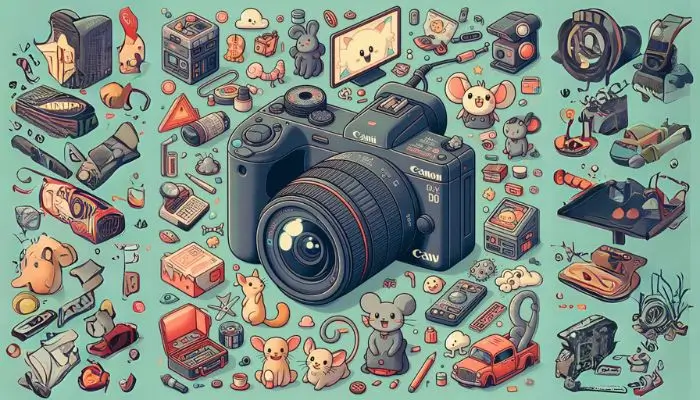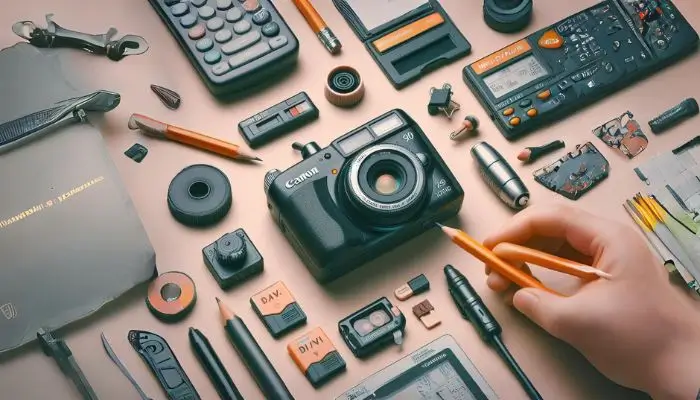Do you have a stack of MiniDV tapes filled with precious memories shot on your Canon CA920 camera? I’m a seasoned videographer with years of experience working with vintage camcorder formats.
In this guide, I’ll share step-by-step instructions on how to unlock those moments, from playing tapes directly on your CA920 to safely transferring them to your computer for preservation and editing. Whether you’re feeling nostalgic or want to create new projects from old footage, I’m here to help.
Key Takeaways
- MiniDV players were a popular format for consumer camcorders in the late 90s and early 2000s.
- The Canon CA920 likely uses FireWire for transfer to modern computers.
- Basic troubleshooting often involves cleaning tape heads or checking connections.
Harnessing Your Canon CA920 MiniDV Player: A Comprehensive Guide
The Canon CA920 camcorder holds a special place in the hearts of many, offering a compact way to capture memories on the go. Its integrated MiniDV player lets you relive those moments directly on the camera or output them to a TV. Let’s dive into how to use this vintage gem!

Unboxing and Essential Setup
When you unbox your CA920, you’ll likely find:
- The camcorder itself
- Battery pack
- AC Adapter/Charger
- AV cable (for connecting to a TV)
- Potentially a shoulder strap and other small accessories
Here’s how to get started:
- Charge the battery: Plug the AC adapter into the camera and the other end into a power outlet.
- Insert a MiniDV tape: Locate the tape compartment, open it gently, and slide the tape in with the label facing up. The camera should automatically retract the tape.
- Switch to player mode: Find the main mode switch, likely labeled “Camera” and “Player” (or similar). Flip it to “Player.”
Basic Operations: Playing Your Tapes
Now the fun begins! Here’s the breakdown of your primary playback controls:
- Play/Pause: Starts and pauses tape playback.
- Stop: Fully stops tape playback.
- Rewind: Winds the tape backward.
- Fast-Forward: Quickly moves tape forward.
- Eject: Opens the tape compartment to remove the cassette.
You should see the footage on the CA920’s built-in screen. Let’s explore connecting to a TV!
Connecting to a TV for the Big Screen Experience
The CA920 likely came with a yellow, red, and white RCA AV cable. This allows you to output video and audio to a TV:
- Locate the AV output on the camera: It might be a small multi-pin port or standard RCA jacks.
- Match the colors to the TV’s inputs: Yellow is for video, red and white are for right and left audio channels.
- Switch the TV to the correct input: This is usually labeled “AV” or “Video.”
Now, when you play your tapes, you’ll enjoy them on the larger television screen.
Advanced CA920 MiniDV Features
Let’s delve into settings and features to enhance your experience:
- Shooting Modes: While primarily a player, the CA920 might have basic shooting modes. Look for an “Auto” mode for fully automatic operation and potentially a “Program” mode for some manual tweaks.
- Zoom and Focus: Experiment with the zoom rocker and see if you have any focus control buttons or dials.
- Audio Options: Check for a built-in microphone and explore the menus for the potential to connect an external mic (if the model supports it).
- On-Screen Displays: You may be able to toggle date/time stamps or other overlays via the settings menu.

Troubleshooting Common MiniDV Issues
MiniDV tapes and players, while nostalgic, can sometimes run into problems. Here are common ones and what to try:
| Issue | Possible Solutions |
|---|---|
| “Tape Error” Message | Clean tape heads (carefully!), check for tape damage |
| Fuzzy / No Image | Clean lens, check connections, ensure proper TV input |
| Battery Won’t Charge | Test with a different battery if possible, check adapter |
| Jammed Tape | Exercise extreme caution with DIY removal, consider professional repair |
Transferring MiniDV Footage to Your Computer: Preserving Your Memories
The next step in your MiniDV journey is bringing those tapes into the digital age. Here’s how:
What You’ll Need
- FireWire Cable: Most older camcorders, including the CA920 likely use FireWire (also called IEEE 1394) for data transfer. Check your camera’s connections to be sure.
- FireWire Port on Your Computer: Many older PCs had these, but modern ones might not. You may need a FireWire adapter (such as a FireWire to Thunderbolt for Macs).
- Video Editing Software: Options range from basic (like Windows Movie Maker or iMovie) to professional suites like Adobe Premiere.
The Transfer Process (Simplified)
- Connect your CA920 to your computer: Use the FireWire cable and any necessary adapter.
- Switch the camcorder to Player mode
- Open your video editing software: Create a new project and look for the “Import” or “Capture” option.
- Control the tape from your computer: You should now be able to play, rewind, etc. directly from the software.
- Capture the footage: Start recording in your software when you have the segment you want to save.
Important Notes:
- File Formats: Your software will likely convert the footage into a modern format like MP4 during import.
- Long Tapes: Be prepared for lengthy transfer times, as the process usually happens in real-time.
- Advanced Software: Provides more control over quality, file naming, and other details.
You Might Also Like: What Is App Spotlight
How can I play my MiniDV tapes?
Most MiniDV camcorders, like the Canon CA920, have a built-in player. Switch the camera to “Player” mode and use the controls to play, rewind, and fast-forward your tapes. To see them on a bigger screen, connect your camcorder to a TV using the AV output cable.
How do I transfer video from my MiniDV to my computer?
You’ll need a FireWire cable (or an adapter for newer computers) and video editing software. Connect the camcorder to your computer, switch it to “Player” mode, and use your software’s “Import” or “Capture” function to transfer the footage.
What is MiniDV format?
MiniDV was a popular digital videotape format used in camcorders in the late 1990s and early 2000s. It offered improved image quality and storage capacity compared to older analog formats.
How do I charge my Canon MiniDV?
Your Canon MiniDV camcorder likely came with a battery charger. Plug the charger into an outlet and insert the battery. Refer to your camera’s manual for charging times and specific instructions.
Can I charge my Canon camera through USB?
While some newer Canon cameras support USB charging, most MiniDV-era models do not. You’ll need the dedicated battery charger for your specific Canon camcorder.
Congratulations, You’re a MiniDV Master!
You now understand the fundamentals of using your Canon CA920 MiniDV player and have successfully transferred your footage to your computer. Enjoy reliving those memories and transforming them into digital projects.
Frequently Asked Questions (FAQs)
Let’s wrap up with answers to common queries:
My tapes are moldy! Can they be salvaged?
Mild mold might be cleanable with specialized methods. Severe cases may need professional service. Always use caution as mold can be harmful.
How do I find a FireWire adapter?
Online retailers like Amazon or electronics stores carry a variety of adapters. Make sure to match your computer’s port type (USB-C, Thunderbolt, etc.)
Can I connect my MiniDV player to my HDMI TV?
Unfortunately, not directly. You’d need a complex chain of converters (MiniDV to analog, then analog to HDMI) with potential quality loss.
My tapes are blank when I play them, help!
Double-check you didn’t accidentally record over them. Some MiniDV tapes have a tab to prevent re-recording – make sure it’s in the correct position.
